A Framework for Evaluating the Business Analytics Maturity of University Programmes
Abstract
:1. Introduction
- By training existing personnel—although this option seems to be more effective, the complexity of the field raises questions about the structure and the necessary duration of such training. According to American Management Association [7], strengthening the analytical capabilities of a company would imply that, besides math knowledge, a good understanding of finance, operations and marketing, combined with statistical analysis, presentation skills and a focus on problem solving is required.
- By increasing the supply of IT solutions and tools that are easy to use and have a short learning curve.
2. Current State of the Research Field—Related Work
2.1. Assessment of Business Analytics (BA)-Related University Programmes
2.2. Skills Required of Business Analytics Professionals
3. Methodology and Data Collection
3.1. Business Analytics Courses Offered by Romanian Economic Universities
3.2. Business Analytics Jobs on the Romanian Market
4. A Framework for Evaluating the Business Analytics Maturity of University Programmes
- “Problem definition”. The study highlighted in previous paragraphs the need to develop A framework for evaluating the Business analytics maturity of university programmes.
- “Comparison with existing maturity models”. Initially, the articles focused on BA and BA maturity models, published in renowned international journals/conferences, were identified. It was found that most BA maturity models were proposed for industry and only two BA maturity models for universities were identified [4,18]. The two BA maturity models for universities were analysed. This framework aims to fill this gap.
- “Iterative maturity model development”. The process of developing the framework was an iterative process. The framework proposes 4 BA maturity levels: basic, moderate, moderate-advanced and advanced and takes into account the two domains presented in 3.1. In establishing the four maturity levels, we started from:
- the three categories of analysts identified by Davenport in [35]: a. analytical amateurs (those using only spreadsheets); b. analytical semi-professionals (those who know how to use visual tools and create simple models); c. analytical professionals (those who can create algorithms);
- Certified Analytics Professional (CAP®) Examination Study Guide—INFORMS [31];
- The evolution of BA in recent years.
- 1 course in the Statistics category (usually Statistics for business),
- 1 course in the Fundamentals of databases. RDBMS category (typically, Databases)
- 1 course in the Spreadsheet software for analysis category
- 1 course in the Econometrics category.
5. Analysis and Results
5.1. Analysis of BA Courses Offered by Romanian Economics Universities
- How prepared are Romanian business students in BA? Do economic universities offer BA competencies corresponding to the requirements of jobs in the BA field?
- Which faculties offer business analytics programmes or BA courses?
- What are these programmes (or courses) called?
- What are the masters programmes that offer the most analytical courses and at what level of analytical maturity?
- What are the fields of study that offer the most analytical courses and the level of analytical maturity?
5.2. Analysis of the Main Requirements of Business Analytics Jobs on the Romanian Market
- 15 jobs at the basic level
- 16 jobs at the moderate level
- 21 jobs at the moderate-advanced level
- 30 jobs at the advanced level
- The analyical thinking skill is part of the critical thinking competency;
- The ability to work through large amounts of data and the capacity to analyse and synthesize information are part of the Systemic thinking and handling of complexity competency;
- The ability to effectively work in a team environment is part of the competency for cooperation.
6. Discussion and Conclusions
Author Contributions
Funding
Conflicts of Interest
References
- World Economic Forum. The Future of Jobs Report. Centre for the New Economy and Society. In Proceedings of the Word Economic Forum, Geneva, Switzerland, 23—26 January 2018. [Google Scholar]
- Solomon, P. Demand for Analytics Skills Outstrips Supply in all Sectors. Available online: https://www.ft.com/content/58d19eca-adb6-11e3-9ddc-00144feab7de (accessed on 6 February 2019).
- Wixom, B.; Ariyachandra, T.; Douglas, D.; Goul, M.; Gupta, B.; Iyer, L.; Kulkarni, U.; Mooney, J.G.; Phillips-Wren, G.; Turetken, O. The Current State of Business Intelligence in Academia: The Arrival of Big Data. CAIS 2014, 34, 1. [Google Scholar] [CrossRef]
- Dubey, R.; Gunasekaran, A. Education and trainig for successfull career in big data and business analytics. Ind. Commer. Train. 2015, 47, 174–181. [Google Scholar] [CrossRef]
- Advanced and Predictive Analytics Market Study (Excerpt). Available online: https://www.tibco.com/sites/tibco/files/resources/2017-advanced-and-predictive-excerpt-for-tibco.pdf. (accessed on 18 February 2018).
- Your Guide to Bridging the Analytics Skills Gap. Developing Tomorrow’s Data Scientists to Fill Today’s Industry Needs. Available online: https://www.sas.com/content/dam/SAS/en_us/doc/whitepaper1/guide-to-bridging-analytics-skills-gap-108264.pdf (accessed on 6 February 2019).
- American Management Association, Conquering big Data: Building Analytical Skills in Your Organization. Available online: https://cdns3.trainingindustry.com/media/16687264/conquering_big_data_survey_final.pdf (accessed on 6 February 2019).
- Miller, S.; Hughes, D. The Quant Crunch. How the demand for data science skills is disrupting the job market; Burning Glass Technologies: Boston, MA, USA, 2017. [Google Scholar]
- International Data Corporation. Worldwide Semiannual Big Data and Analytics Spending Guide; IDC: Framingham, MA, USA, 2016. [Google Scholar]
- Debortoli, S.; Müller, O.; Brocke, J.V. Comparing Business Intelligence and Big Data Skills. Bus. Inf. Syst. Eng. 2014, 6, 289–300. [Google Scholar] [CrossRef]
- European Comission. Developing Future Skills in Higher Education. ET2020 Working Group on Modernisation of Higher. Available online: http://ec.europa.eu/transparency/regexpert/index.cfm?do=groupDetail.groupDetailDoc&id=23155&no=6 (accessed on 18 January 2019).
- Murawski, M.; Bick, M. Demanded and imparted big data competences: Towards an integrative analysis. In Proceedings of the Twenty-Fifth European Conference on Information Systems, Guimaraes, Portugal, 3–9 July 2017. [Google Scholar]
- Watson, H. The Business Case for Analytics. Available online: https://bized.aacsb.edu/articles/2013/05/the-business-case-for-analytics (accessed on 6 February 2019).
- Bensberg, F.; Buscher, G. The Impact of Big Data on the Job Market—Results from a Job Mining Study. Available online: http://2015.data-forum.eu/sites/default/files/1155-1210_Frank%20Bensberg_SEC.pdf (accessed on 6 February 2019).
- Definition—What does Business Analytics (BA) mean? Available online: https://www.techopedia.com/definition/344/business-analytics-ba (accessed on 2 February 2018).
- Gartner Group. Business Analytics. Available online: https://www.gartner.com/it-glossary/business-analytics. (accessed on 9 February 2018).
- Bologa, R.; Lupu, A. A Model for Predicting Future Demand for Ict Specialists in Romania. Available online: https://ideas.repec.org/a/cys/ecocyb/v50y2017i1p151-168.html (accessed on 6 February 2019).
- Turel, O.; Kapoor, B. A Business Analytics Maturity Perspective on the Gap between Business Schools and Presumed Industry Needs. Available online: https://pdfs.semanticscholar.org/9c11/e6a0fa77d5667a8cbad80cb088173f86e0bd.pdf (accessed on 6 February 2019).
- Schoenherr, T.; Speier-Pero, C.; Speier-Pero, C. Data Science, Predictive Analytics, and Big Data in Supply Chain Management: Current State and Future Potential. J. Bus. Logist. 2015, 36, 120–132. [Google Scholar] [CrossRef]
- Todd, P.A.; McKeen, J.D.; Gallupe, R.B. The Evolution of IS Job Skills: A Content Analysis of IS Job Advertisements from 1970 to 1990. MIS Q. 1995, 19, 1. [Google Scholar] [CrossRef]
- European Comission. European Semester Thematic Factsheet Skills for the Labour Market. Available online: https://ec.europa.eu/info/sites/info/files/european-semester_thematic-factsheet_skills-for-labour-market_en_0.pdf (accessed on 20 January 2019).
- Leon, L.; Seal, K.; Przasnyski, Z.; Wiedenman, I. Skills and Competencies Required for Jobs in Business Analytics: A Content Analysis of Job Advertisements Using Text Mining. Int. J. Bus. Intell. Res. 2017, 8, 1–25. [Google Scholar] [CrossRef]
- Cegielski, C.G.; Jones-Farmer, L.A. Knowledge, Skills, and Abilities for Entry-Level Business Analytics Positions: A Multi-Method Study. Decision Sci. J. Innovative Educ. 2016, 14, 91–118. [Google Scholar] [CrossRef]
- Deaconu, A.; Osoian, C.; Zaharie, M.; Achim, S.A. Competencies in higher education system: An empirical analysis of employers’ perceptions. Amfiteatru Econ. J. 2014, 16, 857–873. [Google Scholar]
- Shanghai Ranking’s Global Ranking of Academic Subjects 2018—Economics. 2018. Available online: http://www.shanghairanking.com/shanghairanking-subject-rankings/economics.html (accessed on 26 August 2018).
- Future-proof your Career. Why you need Left and Right Brain Skills for Tomorrow’s Jobs. A Bentley University-commissioned Analysis of Labor Market Data. Available online: http://www.bentley.edu/prepared/2016-jobs-skills (accessed on 20 March 2016).
- Gupta, B.; Goul, M.; Dinter, B. Business Intelligence and Big Data in Higher Education: Status of a Multi-Year Model Curriculum Development Effort for Business School Undergraduates, MS Graduates, and MBAs. CAIS 2015, 36, 23. [Google Scholar] [CrossRef]
- Mitri, M.; Palocsay, S. Toward a Model Undergraduate Curriculum for the Emerging Business Intelligence and Analytics Discipline. CAIS 2015, 37, 31. [Google Scholar] [CrossRef]
- Schiller, S.; Goul, M.; Iyer, L.S.; Sharda, R.; Schrader, D.; Asamoah, D. Build Your Dream (Not Just Big) Analytics Program. CAIS 2015, 37, 40. [Google Scholar] [CrossRef]
- Wixom, B.; Ariyachandra, T.; Goul, M.; Gray, P.; Kulkarni, U.; Phillips-Wren, G. The Current State of Business Intelligence in Academia. CAIS 2011, 29, 16. [Google Scholar] [CrossRef]
- Taber, A.; Samaddar, S.; Bordley, R.; Musa, R.; Smith, M.; Stein, F.; Truxillo, C.; Waltz, Z. Certified Analytics Professional (Cap) Examination Study Guide. Available online: https://www.informs.org. (accessed on 16 August 2018).
- Afla care sunt principalele siteuri de joburi din Romania. Available online: https://www.hipo.ro/locuri-de-munca/vizualizareArticol/1220/Afla-care-sunt-principalele-siteuri-de-joburi-din-Romania (accessed on 31 May 2018).
- Kim, J.Y.; Lee, C.K. An Empirical Analysis of Requirements for Data Scientists Using Online Job Postings. IJSEIA 2016, 10, 161–172. [Google Scholar] [CrossRef]
- Becker, J.; Knackstedt, R.; Poeppelbuss, J. Developing Maturity Models for IT Management. Bus. Inf. Syst. Eng. 2009, 1, 213–222. [Google Scholar] [CrossRef]
- Davenport, T.; Harris, J.G. Competing on Analytics: The New Science of winning; Harvard Business School Press: Boston, MA, USA, 2007. [Google Scholar]
- Occupanional Information Network. Available online: https://www.onetonline.org/ (accessed on 6 February 2019).
- Rieckmann, M. Future-oriented higher education: Which key competencies should be fostered through university teaching and learning? Futures 2012, 44, 127–135. [Google Scholar] [CrossRef]
- Lambrechts, W.; Mulà, I.; Ceulemans, K.; Molderez, I.; Gaeremynck, V. The integration of competences for sustainable development in higher education: an analysis of bachelor programs in management. J. Clean. Prod. 2013, 48, 65–73. [Google Scholar] [CrossRef]
- National qualifications authority. Referencing the Romanian National Qualifications Framework to the European Qualifications Framework. Available online: http://ec.europa.eu/transparency/regexpert/index.cfm?do=groupDetail.groupDetailDoc&id=28729&no=10 (accessed on 17 January 2019).
- Zaharia, S.E.; Barlea, G.; Korka, M. Verification of Compatibility of the Romanian National Qualifications Framework for Higher Education with the Framework for Qualifications of the European Higher Education Area. Available online: https://cnred.edu.ro/sites/default/files/pdf/Self_certification_Report_RO_2011.pdf (accessed on 17 January 2019).
- Sallam, R.L.; Howson, C.; Idoine, C.; Oestreich, T.W. Magic Quadrant for Business Intelligence and Analytics Platforms. Available online: https://www.gartner.com/doc/3861464/magic-quadrant-analytics-business-intelligence (accessed on 22 August 2018).
- The State of Data Education in 2016. How U.S. higher education responds to the data skills gap. Available online: https://www.tableau.com/data-education-2016. (accessed on 19 October 2017).
- Studyportals Masters. Available online: https://www.mastersportal.com/ (accessed on 28 May 2018).
- What’s next for the Data Science and Analytics Jobs Market? Available online: https://www.pwc.com/us/en/library/data-science-and-analytics.html (accessed on 6 February 2019).
- Clare Hopping, J.C. Europe Needs 346,000 More Data Scientists by 2020, but why is the Gap so Big? Available online: https://www.itpro.co.uk/careers/28929/data-scientist-jobs-where-does-the-big-data-talent-gap-lie (accessed on 6 February 2019).
- Enter the Data Economy, EU Policies for a Thriving Data Ecosystem—Strategic Notes. Available online: https://ec.europa.eu/epsc/sites/epsc/files/strategic_note_issue_21.pdf (accessed on 25 September 2018).
- Mocanu, C.; Zamfir, A.M.; Pirciog, S. Matching Curricula with Labour Market Needs for Higher Education: State of Art, Obstacles and Facilitating Factors. Procedia Soc. Behav. Sci. 2014, 149, 602–606. [Google Scholar] [CrossRef]
- Howson, C.; Duncan, A. ITScore Overview for BI and Analytics. Available online: https://www.gartner.com/doc/3136418/itscore-overview-bi-analytics#-1149813958 (accessed on 15 September 2018).
- Halper, F.; Stodder, D. TDWI Analytics Maturity Model Guide. Tdwi Benchmark Guide. Available online: https://tdwi.org/whitepapers/2014/10/tdwi-analytics-maturity-model-guide.aspx (accessed on 6 February 2019).
- Gardner, M. The Analytics Maturity Model: Five Levels of Capabilities. Available online: https://www.logianalytics.com/bi-trends/analytics-maturity-model/ (accessed on 3 March 2018).
- Jenner, C. What is the Business Intelligence & Analytics Maturity Model? Available online: http://www.arbelatech.com/insights/blog/what-is-the-business-intelligence-analytics-maturity-model.html (accessed on 6 February 2019).
- Transforming Our World: The 2030 Agenda for Sustainable Development. Available online: https://sustainabledevelopment.un.org/post2015/transformingourworld/publication (accessed on 6 February 2019).

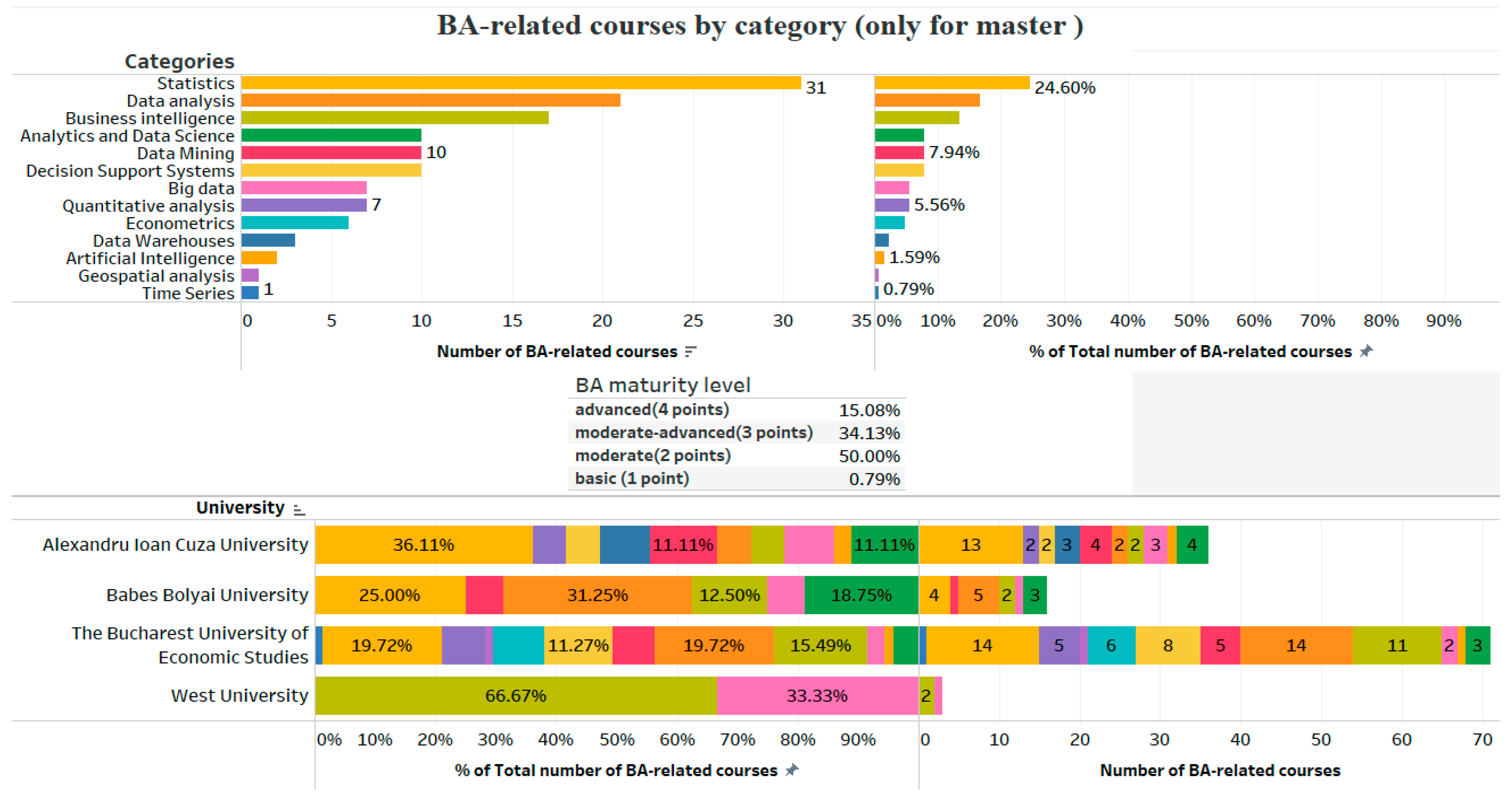


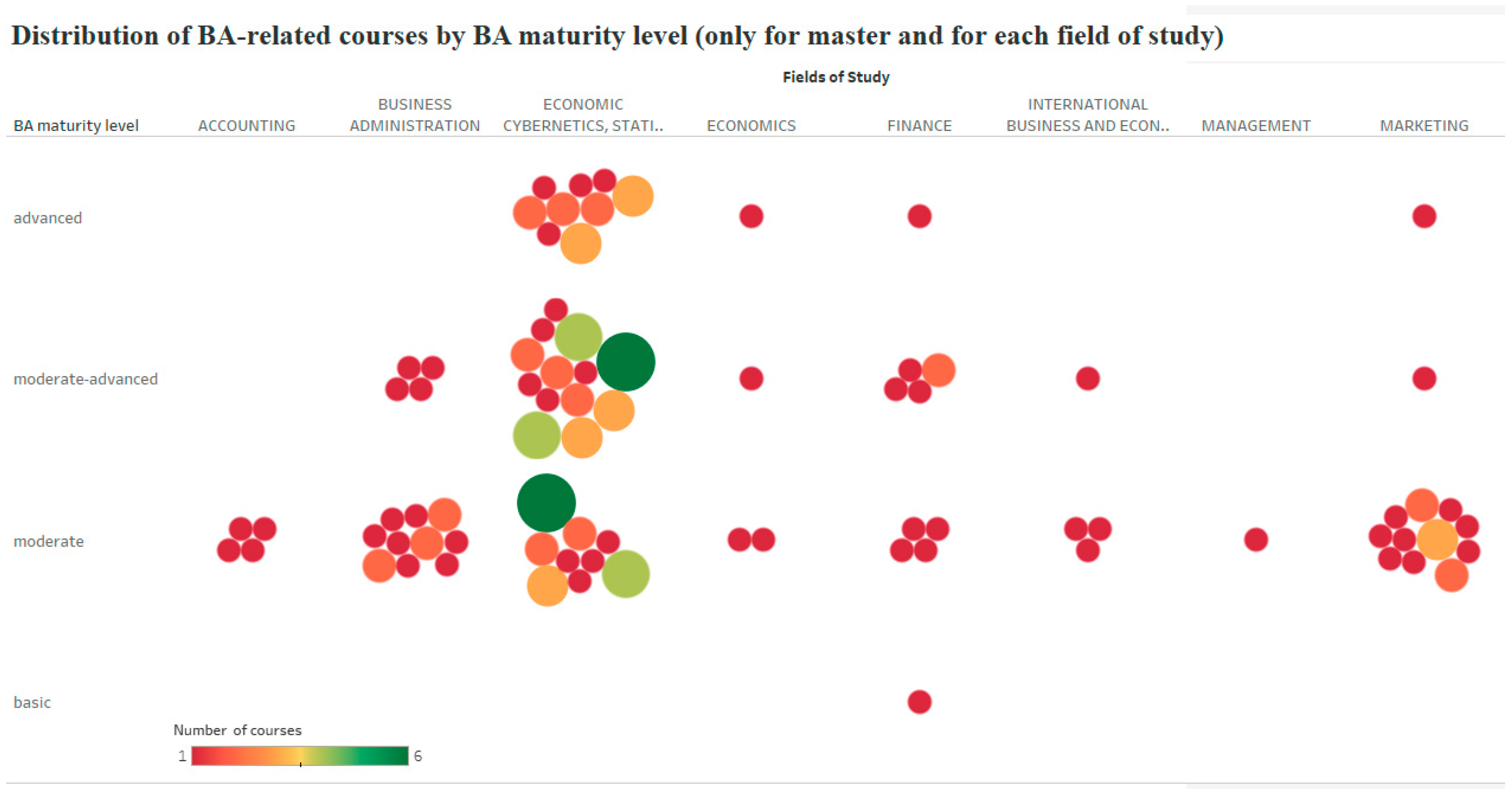
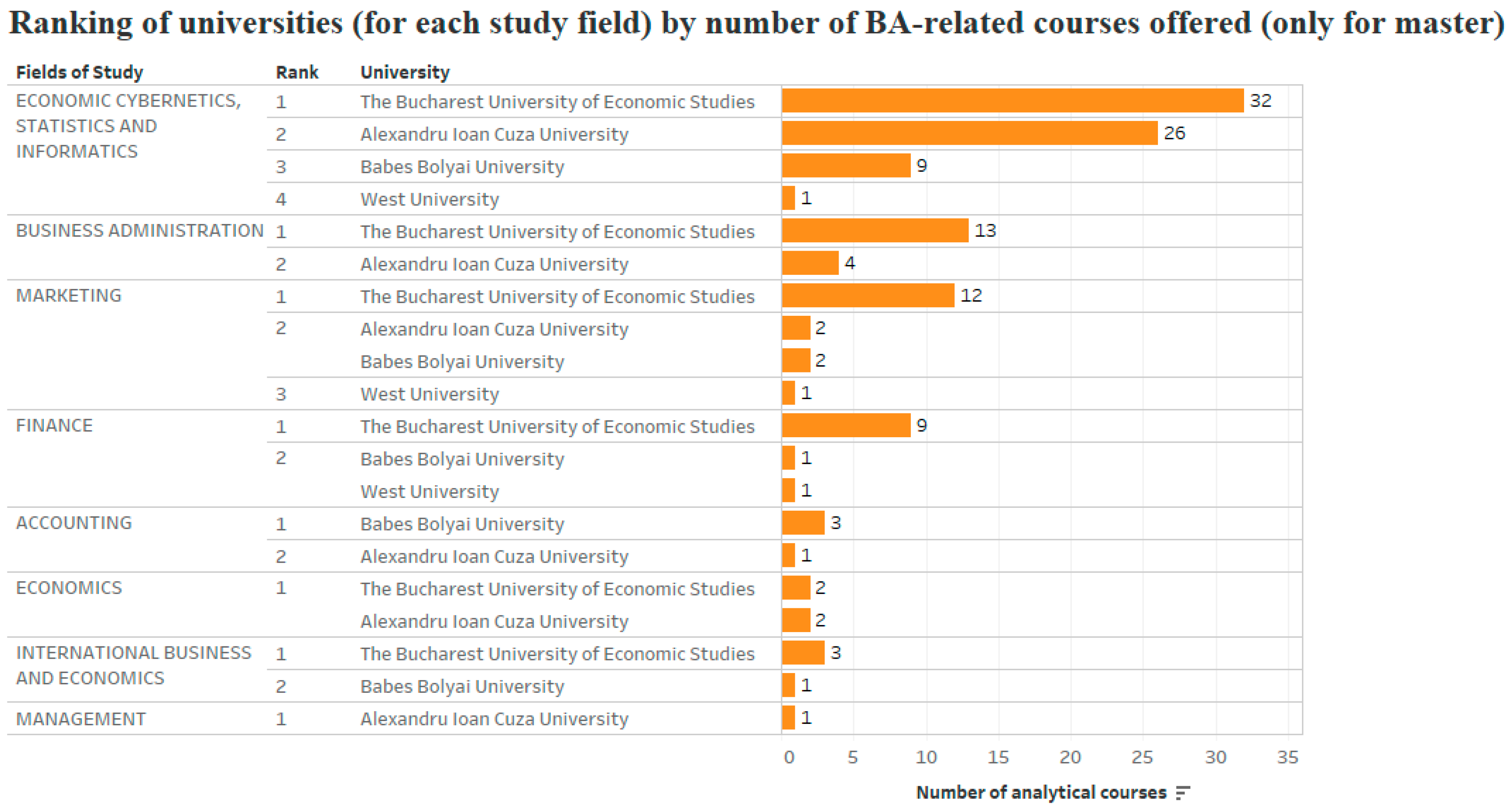
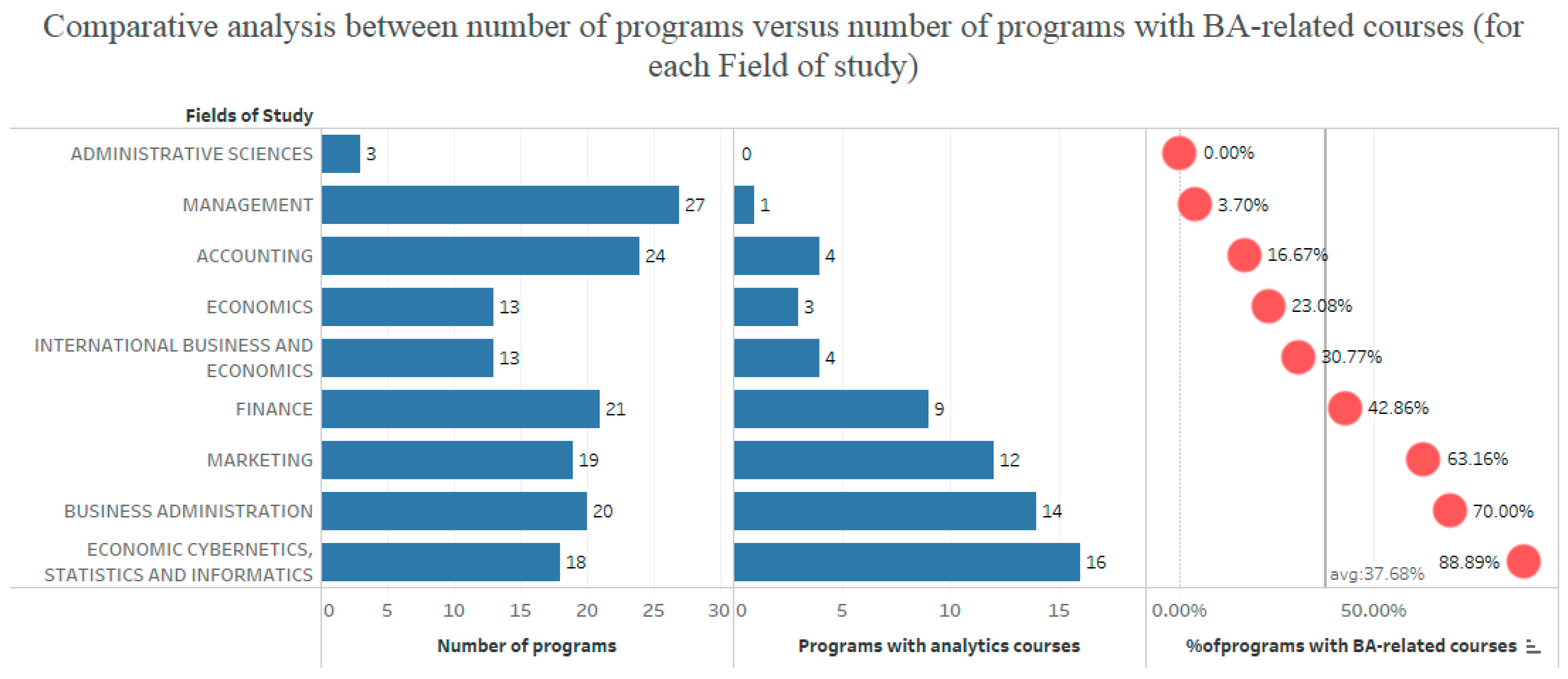
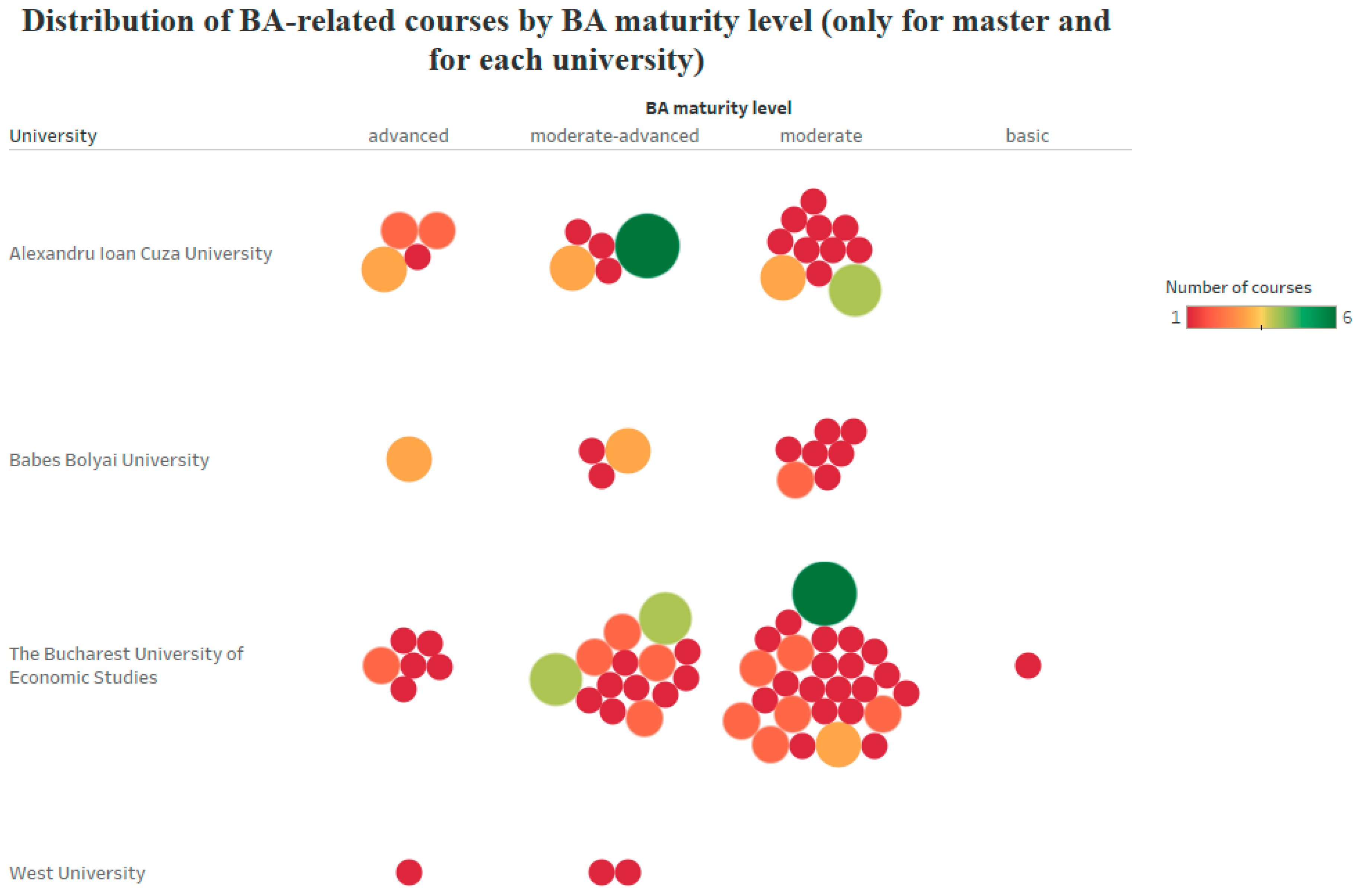
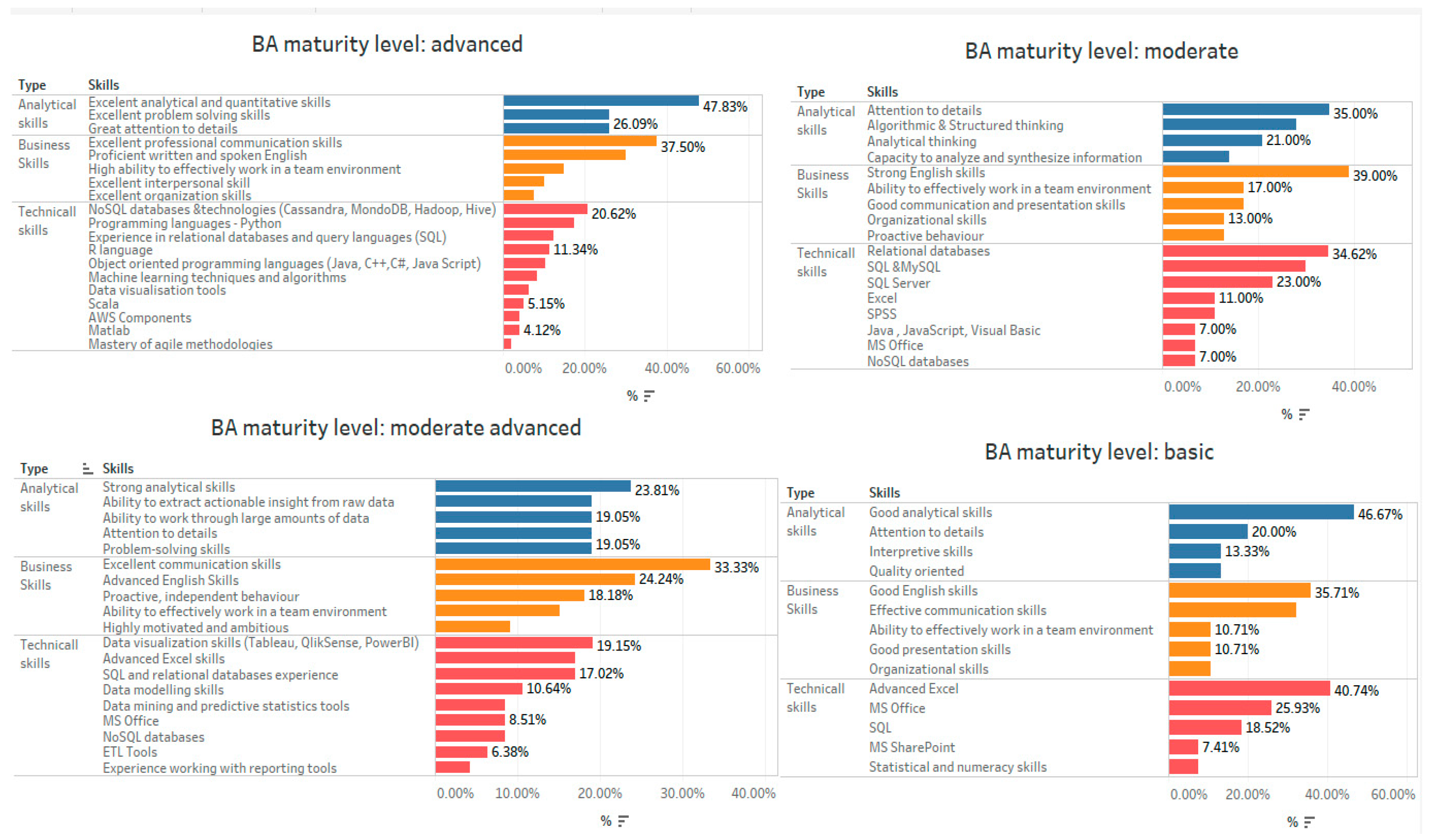
| Domains. | Categories | Analytical Courses |
|---|---|---|
| Big Data Management &Computing Infrastructure | Big Data | Advanced Database Elements (NoSQL) |
| BI and Big Data, Big Data, Big Data and Web Computing, Big Data Management, Polyglot Persistence and Big Data | ||
| Data Warehouses | Data Warehouses | |
| Fundamentals of Databases. RDBMS | Advanced Databases, Database Management Systems, Databases, Databases and Programs, Databases for Accounting and Finance, Databases in Economy, Financial and Banking Databases Management Systems, Oracle RDBMS, Relational Databases Management | |
| Business Analytics | Analytics and Data Science | Analytics and Data Science, Data Science Methods |
| Big Data Analytics | ||
| Business Analytics | ||
| Expert Systems | ||
| Hybrid Intelligent Systems, Intelligent Systems | ||
| Natural Language Processing | ||
| Neuronal Networks | ||
| Software for Quantitative Analysis and Modelling | ||
| Artificial Intelligence | Artificial Intelligence, Artificial Intelligence for Business Knowledge Management | |
| Business Intelligence | Business Assistance Systems | |
| Business intelligence, Business Intelligence Systems, Information Systems for Business Intelligence | ||
| Data Visualization | ||
| OLAP Technology | ||
| Data Analysis | Advanced Marketing Data Analysis, Advanced Online Marketing Data Analysis, Data Analysis, Data Analysis and Statistical Analysis Systems, Data Analysis Software, Data Analysis using SPSS, etc. |
| BA | Basic (1point) | Moderate (2 points) | Moderate-Advanced (3 points) | Advanced (4 points) |
|---|---|---|---|---|
| Descriptive | simple statistical techniques (standard deviation, mean, median, frequency distribution, sampling methods) | |||
| Predictive | —Operational research —Game Theory | —Simulation —Advanced statistics such as: regression (logistic, linear, step-wise, multiple), statistical inferences (confidence intervals, hypothesis testing, analysis of variance, design of experiments), analysis of variance (ANOVA), Forecasting, time series analysis —Data mining (classification algorithms/ clustering algorithms/ frequent pattern mining, association rules) | —Machine learning —Text analytics —Artificial Intelligence (Artificial neural networks, Expert systems) —Spatial machine learning | |
| Prescriptive | —Decision theory/decision modelling —Decision trees | —Optimization algorithms —Fuzzy rule-based System —Switching neural networks (logic learning machine) |
| BA Maturity Level | ||||
|---|---|---|---|---|
| Level | Basic (1 point) | Moderate (2 points) | Moderate-Advanced (3 points) | Advanced (4 points) |
| Bachelor | Basics of Econometrics Basics of Statistics Macroeconomics Database Management Systems Descriptive Statistics Econometrics Economic Informatics Economics Statistics Financial and Banking Databases Management Systems Office Applications Technology in Management etc. | Advanced Databases Data Analysis Decision Support Systems Economic Statistics Games Theory Geospatial Modeling and Visualisation of Statistical Data Information Analysis using SPSS Marketing Data Analysis Multidimensional Statistical Analysis etc. | Business Intelligence Computational Intelligence in Economics Data Analysis Inferential Statistics Introduction in Data Mining Multivariate Statistics Statistical Hypothesis Testing | Advanced Database Elements (NoSQL) Artificial Intelligence Time Series Time Series Analysis Time Series Analysis and Prevision |
| Master | Fundamentals of Econometrics | Actuarial Statistics Advanced Marketing Data Analysis Data Analysis Data Analysis and Statistical Analysis Systems Data Analysis using SPSS Decision Support Systems Geospatial Analysis applied to marketing etc. | Advanced Econometrics Advanced Statistics Bayesian Statistics Business Intelligence Cluster Analysis Computational Statistics Data Mining Data Mining and Knowledge Discovery Data Mining and Simulation etc. | Analytics and Data Science Artificial Intelligence BI and Big Data Big Data Analytics Data Science Methods Hybrid Intelligent Systems Intelligent Systems Natural Language Processing Neuronal Networks etc. |
| BA Maturity Level | Domain | Knowledge | Hard (Technical) Skills |
|---|---|---|---|
| Advanced level | Big data management and computing infrastructure | —advanced knowledge of techniques to capture and manage big data (non-relational components and distributed data storage) —advanced knowledge of techniques to integration big data —strong knowledge of big data modelling techniques —strong knowledge of big data cleansing techniques | —high proficiency with a variety of NoSQL database platforms (Cassandra, CouchDB, HBase, MongoDB); —high proficiency with data integration tools (Informatica, Talend, etc.) and preparation tools (Alteryx Analytics, SAS Data Loader for Hadoop, etc.); —experience with Data Quality & Data Profiling metrics and tools —good skills with Apache Hadoop ecosystem and related data technologies (Apache Hadoop, MapReduce, HIVE, HBase); —advanced skills with big data modelling tools (ERWin, Enterprise Architect Visio, etc.); —experience with Agile delivery methodologies (SCRUM) |
| Business analytics (data science and advanced business analytics) | —advanced knowledge of visualization techniques and dashboard design; —advanced knowledge of predictive modelling concepts, machine learning approaches, clustering and classification techniques, deep learning algorithms, —advanced knowledge of prescriptive techniques; —advanced knowledge of design and implement domain-specific models and techniques such as marketing analytics, finance analytics, supply chain analytics, digital marketing and Social Media analytics, etc. —advanced knowledge of big data programming | —advanced skills with Data visualization tools (QlikView, Tableau, SAS, Analytica); —advanced skills with SAS/Analytica for simulation —advanced skills with R, Python, Scala, SAS for predictive modelling; —advanced skills with machine learning tools (Apache Mahout, R, Spark, Scala); —advanced skills with MATLAB for data mining, optimization, simulation; —advanced skills with SPSS Modeler, SAS Enterprise Miner; —advanced skills in NPL (Watson Natural Language Understanding, Standford NPL); | |
| Moderate-advanced level | Big data management and computing infrastructure | —strong knowledge of RDBMS, database tuning and performance —good knowledge of NoSQL databases —good knowledge of ETL techniques —good knowledge of data warehousing concepts, data warehouse structures, data mart, design, implementation, management, data architecture of OLTP and data warehouse —depth knowledge of dimensional data modelling (star/snowflake schema) and methodologies | —good skills with a variety of NoSQL database platforms (Cassandra, CouchDB, HBase, MongoDB) —good skills with a variety of ETL tools (Microsoft SSIS-SQL Integration Services, ODI, etc.) —proficiency with a variety of data warehousing platforms (Oracle, IBM, Microsoft) —good skills with data modelling tools and methodologies (ERWin, Enterprise Architect Visio, UML, etc.) |
| Business analytics | —good knowledge of BI (business reporting, OLAP), good knowledge of the methods, procedures and techniques of report writing —good knowledge of GIS; —good knowledge of visualization techniques and dashboard design; —good knowledge of in-database analytics; —good knowledge of predictive analytics (such as: regression, statistical inferences, simulation, forecasting models, data mining); —good knowledge of operational research and econometrics; —good knowledge of decision theory; —good knowledge of Big data programming; | — proficiency with BI platforms (Oracle OBIEE, Business Objects, Cognos, MicroStrategy, Microsoft Analysis/ Integration/ Reporting Services, Microsoft DAX Language, Crystal Reports) —experience in building data visualization dashboards using Tableau/QlikView/Power BI —proficiency with SQL analytics (experience creating advanced SQL queries) —good skills with data mining tools (IBM Watson, SAS Enterprise Miner, KNIME, Rapid Miner) —experience using Python/R/MATLAB for analysis —proficiency with Google analytics (for marketers) | |
| Moderate level | Big data management and computing infrastructure | —good knowledge of databases and query languages; —knowledge of ERD, database design (other BD courses) and cleaning data; —basic knowledge of Big data programming; | —experience with SQL database systems (Oracle, SQL Server, Postgres, MySQL), reading and writing SQL code —core skills with NoSQL databases (MongoDB) —core skills with data modelling tools and methodologies (UML, etc.) —basic skills with R/Python |
| Business analytics | —basic knowledge of visualization techniques; —basic knowledge of BI concepts, report techniques; —basic knowledge of GIS concepts; —good knowledge of statistics (other statistics courses, Survey Statistics, Quantitative analysis); —good knowledge of econometrics (other econometrics courses); —knowledge of Decision Support Systems; —knowledge of operational research; | —some experience with Data visualization tools (Qlik sense cloud, Power BI) —some experience with BI platforms (Power BI) —some experience with GIS platforms (ArcGIS online) —experience using statistical packages for analysing datasets (SAS/SPSS) | |
| Basic level (foundation) | Big data management and computing infrastructure | —core knowledge of databases (concepts, data models, database design, development, relational database concepts) | —basic skills with Oracle database/MySQL database /Microsoft SQL database/Access database —basic understanding of SQL, reading and writing basic SQL code |
| Business analytics | —basic knowledge of statistics (descriptive techniques); —basic knowledge of econometrics; | —essential skills in SPSS, SAS —advanced proficiency with Excel |
| Model Level | Top Business Skills | Top Analytical skills | Top Technical Skills and Knowledge |
|---|---|---|---|
| Basic | Good English skills Effective communication skills Communication skills Ability to effectively work in a team environment Organizational skills | Good analytical skills Attention to details Quality-oriented Interpretive skills | Advanced Excel MS Office SQL |
| Moderate | Strong English skills Good communication and presentation skills Ability to effectively work in a team environment Organizational skills Proactive behaviour | Analytical thinking Attention to details Algorithmic and structured thinking Capacity to analyse and synthesize information | Relational databases SQL Server SQL language MySQL Proficient Excel SPSS NoSQL databases Office Java, JavaScript, Visual Basic |
| Moderate-advanced | Advanced English skills Excellent communication skills Ability to effectively work in a team environment Proactive, independent behaviour Highly motivated and ambitious | Strong analytical skills Attention to details Problem-solving skills Ability to work through large amounts of data Ability to extract actionable insight from raw data | Data visualization skills (Tableau, Qlik sense, PowerBI) SQL and relational databases experience Advanced Excel skills Data modelling skills MS Office Data mining and predictive statistics tools NoSQL databases ETL tools Experience working with reporting tools |
| Advanced | Proficient written and spoken English Excellent professional communication skills High ability to effectively work in a team environment Excellent organization skills Excellent interpersonal skills | Excellent analytical and quantitative skills Great attention to detail Excellent problem-solving skills | NoSQL databases and technologies (Cassandra, MongoDB, Hadoop, Hive) Programming languages – Python Experience in relational databases and query languages (SQL) R language Object oriented programming languages (Java, C++, C#, Java Script) Mastery of agile methodologies |
| Basic Level Jobs | Moderate Level Jobs | Moderate-Advanced Level Jobs | Advanced Level Jobs |
|---|---|---|---|
| Business Analyst Customer Data Quality Analyst, Data Governance Analyst, Data Analyst Data Analyst Engineer (junior), Data Technical Analyst, FP&A Analyst, Junior Marketing Analyst, Supply chain analyst | Database Administrator, Customer Master Data Analyst, Data Analyst, Data Architect, Data Research Analyst, Database Developer Senior Market Research Data Analyst, Statistician | Associate Data Engineer, BI and Analytics Analyst, Business Analyst, Data Analyst, Data Analyst with Python/R Programming Language, Data Engineer, Data Scientist, Database Administrator, Digital Data Analyst, Digital Marketing Data Scientist, ETL BI Engineer, Java/Database Developer | BI Analyst Developer, Big Data Architect, Big Data Consultant, Big Data Engineer, Business Analyst, Business Intelligence Engineer, Data Analyst Data Analytics Specialist Data Architect Data Engineer for Big Data Data Engineer Data Scientist Data scientist - Data analyst Data Scientist - Data Engineer Data Scientist Manager Data Warehouse Architect Machine Learning Engineer SAP Big Data and Cloud Analytics Senior Data Scientist for IoT |
© 2019 by the authors. Licensee MDPI, Basel, Switzerland. This article is an open access article distributed under the terms and conditions of the Creative Commons Attribution (CC BY) license (http://creativecommons.org/licenses/by/4.0/).
Share and Cite
Muntean, M.; Bologa, A.-R.; Corbea, A.M.I.; Bologa, R. A Framework for Evaluating the Business Analytics Maturity of University Programmes. Sustainability 2019, 11, 853. https://doi.org/10.3390/su11030853
Muntean M, Bologa A-R, Corbea AMI, Bologa R. A Framework for Evaluating the Business Analytics Maturity of University Programmes. Sustainability. 2019; 11(3):853. https://doi.org/10.3390/su11030853
Chicago/Turabian StyleMuntean, Mihaela, Ana-Ramona Bologa, Alexandra Maria Ioana Corbea, and Razvan Bologa. 2019. "A Framework for Evaluating the Business Analytics Maturity of University Programmes" Sustainability 11, no. 3: 853. https://doi.org/10.3390/su11030853
APA StyleMuntean, M., Bologa, A.-R., Corbea, A. M. I., & Bologa, R. (2019). A Framework for Evaluating the Business Analytics Maturity of University Programmes. Sustainability, 11(3), 853. https://doi.org/10.3390/su11030853






